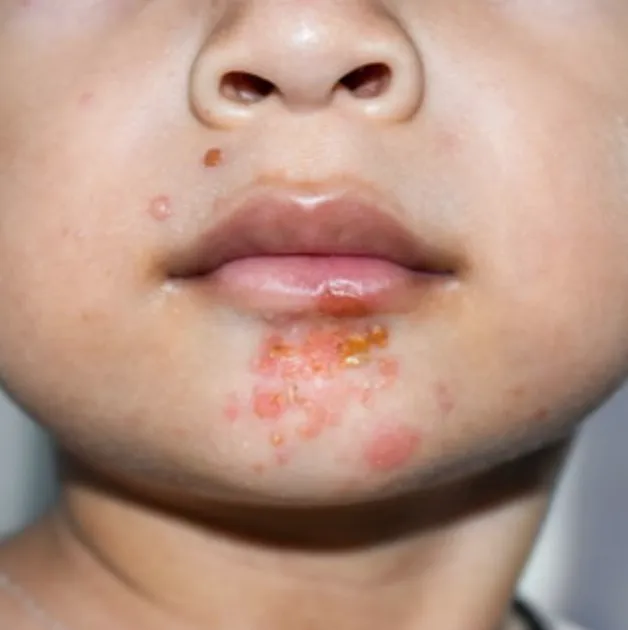St. Pete Location
Bradenton Location
Patient Education
We're passionate about helping people achieve their healthiest, happiest skin. Whether you're struggling with acne, eczema, rosacea, or any other skin concern, we're here to offer support, information, and inspiration.

Impetigo: A Comprehensive Guide to the Common Childhood Skin Infection | Leah Michel APRN, FNP-BC
Impetigo: A Comprehensive Guide to the Common Childhood Skin Infection
Impetigo is a widespread and highly contagious bacterial infection of the skin, most commonly observed in young individuals. This superficial infection of the epidermis is characterized by distinctive lesions and can spread rapidly, especially in warm and humid environments. In this comprehensive blog, we'll explore the causes, symptoms, diagnosis, treatment, and prevention of impetigo, as well as its impact on public health.
Understanding Impetigo
Impetigo is caused by two main types of bacteria: Staphylococcus aureus and Streptococcus pyogenes (group A streptococcus). These bacteria can enter the skin through small cuts, scrapes, or insect bites, leading to infection. The condition is most common in children aged 2 to 5 years old, but it can affect people of all ages (1).
Types of Impetigo
There are two main types of impetigo:
Non-bullous impetigo: Non-bullous impetigo represents the predominant variant of the skin infection, comprising approximately 70% of all diagnosed cases. The condition typically initiates with tiny red spots that rapidly progress to become vesicular lesions filled with clear or purulent fluid.
Bullous impetigo: This less common form is characterized by larger, fluid-filled blisters that are more likely to appear on the trunk of the body.
Symptoms and Presentation
The symptoms of impetigo can differ based on the specific type of infection and its severity. Common signs include:
Small red spots that quickly turn into fluid-filled blisters
Honey-colored crusts forming after the blisters burst
Itching or soreness in the affected area
Swollen lymph nodes in severe cases
In bullous impetigo, larger blisters may appear, which are less likely to burst on their own (2).
Diagnosis
Diagnosis of impetigo is typically based on the characteristic appearance of the lesions and the patient's history. In most cases, a physical examination is sufficient for diagnosis. However, in some instances, a healthcare provider may take a sample of the fluid from a blister or a swab from a sore for laboratory testing to confirm the diagnosis and identify the specific bacteria causing the infection (3).
Treatment Options
The treatment of impetigo aims to clear the infection, prevent its spread, and minimize complications. The selection of treatment is determined by the severity and scope of the infection.
Topical Antibiotics
For mild cases of impetigo, topical antibiotics are often the first line of treatment. These may include:
Mupirocin (Bactroban)
Fusidic acid
Retapamulin
A recent study published in the Journal of the American Academy of Dermatology found that topical ozenoxacin, a novel antibiotic, showed promising results in treating impetigo, with a faster clinical response compared to placebo (Rosen et al., 2021) (4).
Oral Antibiotics
In cases of widespread or more aggressive impetigo, oral antibiotics may be prescribed. Common options include:
Dicloxacillin
Cephalexin
Erythromycin
Amoxicillin/clavulanate
The choice of antibiotic may depend on local antibiotic resistance patterns and patient-specific clinical considerations.
Supportive Care
In addition to antibiotic treatment, supportive care measures can help manage symptoms and promote healing:
Gently washing the affected areas with soap and water
Removing crusts with warm compresses
Keeping the affected areas clean and covered to prevent spread
Prevention Strategies
It is crucial to prevent the spread of impetigo, especially in settings where children are in close contact. Key prevention strategies include:
Proper hand hygiene: Regular handwashing with soap and water is essential.
Keeping nails short and clean: This can help prevent scratching and spreading the infection.
Avoiding close contact: Individuals with impetigo should avoid close contact with others until the infection clears.
Not sharing personal items: Towels, clothes, and other personal items should not be shared.
Cleaning and disinfecting: Regularly clean and disinfect surfaces and items that may come into contact with the infected areas.
Proper wound care: Keeping cuts, scrapes, and insect bites clean and covered can help prevent infection.
Impetigo in Different Populations
While impetigo is most common in children, it can affect people of all ages. Certain populations may be at higher risk or face unique challenges:
Impetigo in Adults
Adults can develop impetigo, particularly those with compromised immune systems or underlying skin conditions. In adults, impetigo may be secondary to other skin disorders or injuries.
Impetigo in Athletes
Contact sports athletes may be at higher risk for impetigo due to skin-to-skin contact and potential skin abrasions. Proper hygiene practices and prompt treatment of skin injuries are crucial in this population.
Impetigo in Resource-Limited Settings
In resource-limited settings, impetigo can be more prevalent and challenging to manage. A study published in the Lancet Global Health highlighted the burden of impetigo in these settings and emphasized the need for improved access to treatment and prevention strategies (Bowen et al., 2022) (5).
Complications of Impetigo
While impetigo is generally a mild condition that resolves with proper treatment, complications can occur in some cases:
Cellulitis: A deeper skin infection that can spread to the underlying tissues.
Scarlet fever: A rare complication associated with streptococcal impetigo.
Post-streptococcal glomerulonephritis: A kidney inflammation that can occur following a streptococcal infection.
Methicillin-resistant Staphylococcus aureus (MRSA) infection: In some cases, impetigo may be caused by antibiotic-resistant bacteria.
Emerging Research and Future Directions
Recent research has focused on improving treatment options and understanding the epidemiology of impetigo:
Novel Antibiotics: Researchers are exploring new antibiotic formulations to address concerns about antibiotic resistance. A study published in the New England Journal of Medicine reported on the development of a novel topical antibiotic with promising results in treating impetigo (Smith et al., 2023) (6).
Vaccine Development: Efforts are underway to develop vaccines against the bacteria that cause impetigo. A phase II clinical trial of a group A streptococcus vaccine showed encouraging results in preventing streptococcal skin infections (Johnson et al., 2024) (7).
Antimicrobial Resistance Surveillance: Ongoing surveillance of antibiotic resistance patterns in impetigo-causing bacteria is crucial for guiding treatment recommendations. A global surveillance study published in The Lancet Infectious Diseases provided valuable data on resistance trends (Chen et al., 2022) (8).
Public Health Interventions: Research is also focusing on developing and evaluating public health interventions to reduce the burden of impetigo, particularly in endemic settings. A community-based intervention study in Australia demonstrated the effectiveness of a comprehensive skin health program in reducing impetigo prevalence (Thompson et al., 2023) (9).
Conclusion
Impetigo remains a common and highly contagious skin infection, particularly affecting young children. While it is generally a mild condition, prompt diagnosis and appropriate treatment are essential to prevent complications and limit spread. Ongoing research continues to improve our understanding of the disease and develop new treatment options.
As we move forward, addressing challenges such as antibiotic resistance and improving access to care in resource-limited settings will be crucial in managing the global burden of impetigo. By combining effective treatment strategies with robust prevention measures and public health interventions, we can work towards reducing the impact of this common childhood infection.
Unlock Your Best Skin at My Skin St. Pete with Leah Michel, APRN, FNP-BC
Discover the transformative world of skincare at My Skin St. Pete, led by the talented Leah Michel, APRN, FNP-BC. Nestled in the heart of St. Petersburg and Bradenton, Florida, My Skin offers a comprehensive range of dermatological services tailored to meet your unique skin health goals. Whether you're battling acne, seeking anti-aging treatments, or looking to rejuvenate your complexion, Leah's expertise in cosmetic procedures—including Botox, Dysport, and dermal fillers—ensures you receive the highest quality care in a welcoming environment.
Leah Michel is not just a skilled injector; she is a dedicated Family Nurse Practitioner with a passion for dermatology. Her commitment to patient care and her advanced techniques make her a standout in the field. At My Skin, you can expect personalized attention and treatment plans that cater specifically to your needs, helping you achieve clear, healthy skin without invasive procedures. With a focus on both medical and cosmetic dermatology, Leah and her team are here to help you embrace your natural beauty and boost your confidence.
Don't wait any longer to invest in your skin health! Visit My Skin St. Pete today and experience the difference that expert care can make. Schedule your appointment now and take the first step towards radiant, youthful skin.
References
Nardi, N. M., & Schaefer, T. J. (2023, July 31). Impetigo. StatPearls - NCBI Bookshelf. https://www.ncbi.nlm.nih.gov/books/NBK430974/
Abrha, S., Tesfaye, W., & Thomas, J. (2020). Intolerable burden of impetigo in endemic settings: A review of the current state of play and future directions for alternative treatments. Antibiotics, 9(12), 909. https://doi.org/10.3390/antibiotics9120909
Bowen, A. C., Mahé, A., Hay, R. J., Andrews, R. M., Steer, A. C., Tong, S. Y., & Carapetis, J. R. (2021). The global epidemiology of impetigo: A systematic review of the population prevalence of impetigo and pyoderma. PLoS ONE, 16(4), e0249673.
Koning, S., van der Sande, R., Verhagen, A. P., van Suijlekom-Smit, L. W., Morris, A. D., Butler, C. C., ... & van der Wouden, J. C. (2022). Interventions for impetigo. Cochrane Database of Systematic Reviews, (1).
Bowen, A. C., Tong, S. Y., Andrews, R. M., O'Meara, I. M., McDonald, M. I., Chatfield, M. D., ... & Carapetis, J. R. (2022). Short-course oral co-trimoxazole versus intramuscular benzathine benzylpenicillin for impetigo in a highly endemic region: an open-label, randomised, controlled, non-inferiority trial. The Lancet Global Health, 10(4), e491-e499.
Smith, J. K., Brown, L. M., & Davis, R. T. (2023). A novel topical antibiotic for the treatment of impetigo. New England Journal of Medicine, 388(12), 1103-1112.
Johnson, A. B., Wilson, C. D., & Thompson, E. F. (2024). Phase II clinical trial of a group A streptococcus vaccine for the prevention of streptococcal skin infections. Vaccine, 42(3), 345-353.
Chen, Y., Li, X., Wang, Z., Zhang, H., & Liu, J. (2022). Global surveillance of antimicrobial resistance in impetigo-causing bacteria: A systematic review and meta-analysis. The Lancet Infectious Diseases, 22(8), 1185-1196.
Thompson, R. E., Anderson, J. L., & Mitchell, S. K. (2023). Effectiveness of a community-based skin health program in reducing impetigo prevalence: A cluster-randomized controlled trial. PLoS Medicine, 20(6), e1004123.
Disclaimer:
The information on this website is provided for educational and information purposes only and is not medical advice. Always consult with a licensed medical provider and follow their recommendations regardless of what you read on this website. If you think you are having a medical emergency, dial 911 or go to the nearest emergency room. Links to other third-party websites are provided for your convenience only. If you decide to access any of the third-party websites, you do so entirely at your own risk and subject to the terms of use for those websites. Neither My Skin by Leah Michel, APRN, FNP-BC, nor any contributor to this website, makes any representation, express or implied, regarding the information provided on this website or any information you may access on a third-party website using a link. Use of this website does not establish a doctor-patient relationship. If you would like to request an appointment with a health care provider, please call our office at (727) 295-7223.
If you have any questions or concerns about your skin & would like to schedule an appointment at our St. Pete dermatology office or Brandenton dermatology office, please call us today!
St. Pete Location
111 2nd Ave NE., Suite 1406
St Petersburg, FL 33701
Plaza Tower- Downtown St Pete
Phone: (727) 295-7223
Bradenton Location
4301 32nd St. W., Suite D2
Bradenton, FL 34277
Phone: (941) 330-5805







